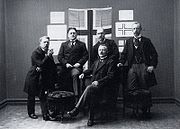
Þórarinn B. Þorláksson
Encyclopedia

Iceland
Iceland , described as the Republic of Iceland, is a Nordic and European island country in the North Atlantic Ocean, on the Mid-Atlantic Ridge. Iceland also refers to the main island of the country, which contains almost all the population and almost all the land area. The country has a population...
's first contemporary painters, the first Icelander to exhibit paintings in Iceland, and recipient of the first public grant that country made to a painter.
Early life and career
Þorláksson was born in 1867, the 13th of 14 children of a clergyman father, who died when Þorláksson was just five years old. Originally trained and working as a bookbinderBookbinding
Bookbinding is the process of physically assembling a book from a number of folded or unfolded sheets of paper or other material. It usually involves attaching covers to the resulting text-block.-Origins of the book:...
, Þorláksson studied painting under a Copenhagen
Copenhagen
Copenhagen is the capital and largest city of Denmark, with an urban population of 1,199,224 and a metropolitan population of 1,930,260 . With the completion of the transnational Øresund Bridge in 2000, Copenhagen has become the centre of the increasingly integrating Øresund Region...
-trained Icelandic woman, Thóra Thoroddsen. In 1900 he was awarded a grant by the Icelandic Parliament
Althing
The Alþingi, anglicised variously as Althing or Althingi, is the national parliament of Iceland. The Althingi is the oldest parliamentary institution in the world still extant...
to study art in Denmark, and he trained there from 1895 to 1899. Returning to Iceland, he held an exhibition of his works at a place perplexingly called Glasgow, in Reykjavík
Reykjavík
Reykjavík is the capital and largest city in Iceland.Its latitude at 64°08' N makes it the world's northernmost capital of a sovereign state. It is located in southwestern Iceland, on the southern shore of Faxaflói Bay...
, in the summer of 1900—the first exhibition of Icelandic painting in Iceland. Þorláksson's principal interest was landscape painting
Landscape art
Landscape art is a term that covers the depiction of natural scenery such as mountains, valleys, trees, rivers, and forests, and especially art where the main subject is a wide view, with its elements arranged into a coherent composition. In other works landscape backgrounds for figures can still...
, and perhaps fittingly a dominant subject in this first exhibition of works was Þingvellir
Þingvellir
|Thing]] Fields) is a place in Bláskógabyggð in southwestern Iceland, near the peninsula of Reykjanes and the Hengill volcanic area. Þingvellir is a site of historical, cultural, and geological importance and is one of the most popular tourist destinations in Iceland. It is the site of a rift...
, a site of enormous historical significance to Icelanders as the site of their parliaments (which dated back to 930 AD).
Later career

Prime Minister of Iceland
The Prime Minister of Iceland is Iceland's head of government. The prime minister is appointed formally by the President and exercises executive authority along with the cabinet subject to parliamentary support....
Hannes Hafstein as one of the five people on the committee that designed the Flag of Iceland
Flag of Iceland
The flag of Iceland was officially described in Law No. 34, set out on 17 June 1944, the day Iceland became a republic. The law is entitled "The Law of the National Flag of Icelanders and the State Arms" and describes the Icelandic flag as follows:...
. He taught drawing at the Technical College and other institutions in Reykjavík, and was principal of that college from 1916 to 1922. He also ran a shop selling art materials, journals and books until his death. Throughout his life he continued to paint, particularly in the countryside during the summers, and it was at his own summerhouse, Birkihlíð, that he died on July 10, 1924.
Þorláksson, together with a small number of other artists including his contemporary Ásgrímur Jónsson
Ásgrímur Jónsson
Ásgrímur Jónsson was an Icelandic painter, and one of the first in the country to make art a professional living. He studied at the Royal Academy in Copenhagen between 1900-1903 and traveled widely after graduation....
, confronted and portrayed the landscape of their country on its terms and through Icelandic eyes, rather than through the conventions—and the light—of Western European artistic tradition. In this respect the work of Þorláksson and Jónsson played a role similar to that of the Heidelberg School
Heidelberg School
The Heidelberg School was an Australian art movement of the late 19th century. The movement has latterly been described as Australian Impressionism....
in Australia (slightly earlier) and the Group of Seven
Group of Seven (artists)
The Group of Seven, sometimes known as the Algonquin school, were a group of Canadian landscape painters from 1920-1933, originally consisting of Franklin Carmichael , Lawren Harris , A. Y. Jackson , Franz Johnston , Arthur Lismer , J. E. H. MacDonald , and Frederick Varley...
, Emily Carr
Emily Carr
Emily Carr was a Canadian artist and writer heavily inspired by the indigenous peoples of the Pacific Northwest Coast. One of the first painters in Canada to adopt a post-impressionist painting style, Carr did not receive widespread recognition for her work until later in her life...
and Tom Thomson
Tom Thomson
Thomas John Thomson , also known as Tom Thomson, was an influential Canadian artist of the early 20th century. He directly influenced a group of Canadian painters that would come to be known as the Group of Seven, and though he died before they formally formed, he is sometimes incorrectly credited...
in Canada (a little later).
Reading
- Ólafur Kvaran (ed.), Þórarinn B. Þorláksson: Pioneer at the Dawn of a Century, Listasafn Íslands, Reykjavík, 2000.
- Ólafur Kvaran and Karla Kristjánsdóttir (eds), Confronting Nature: Icelandic Art of the 20th Century, National Gallery of Iceland, Reykjavík, 2001.

